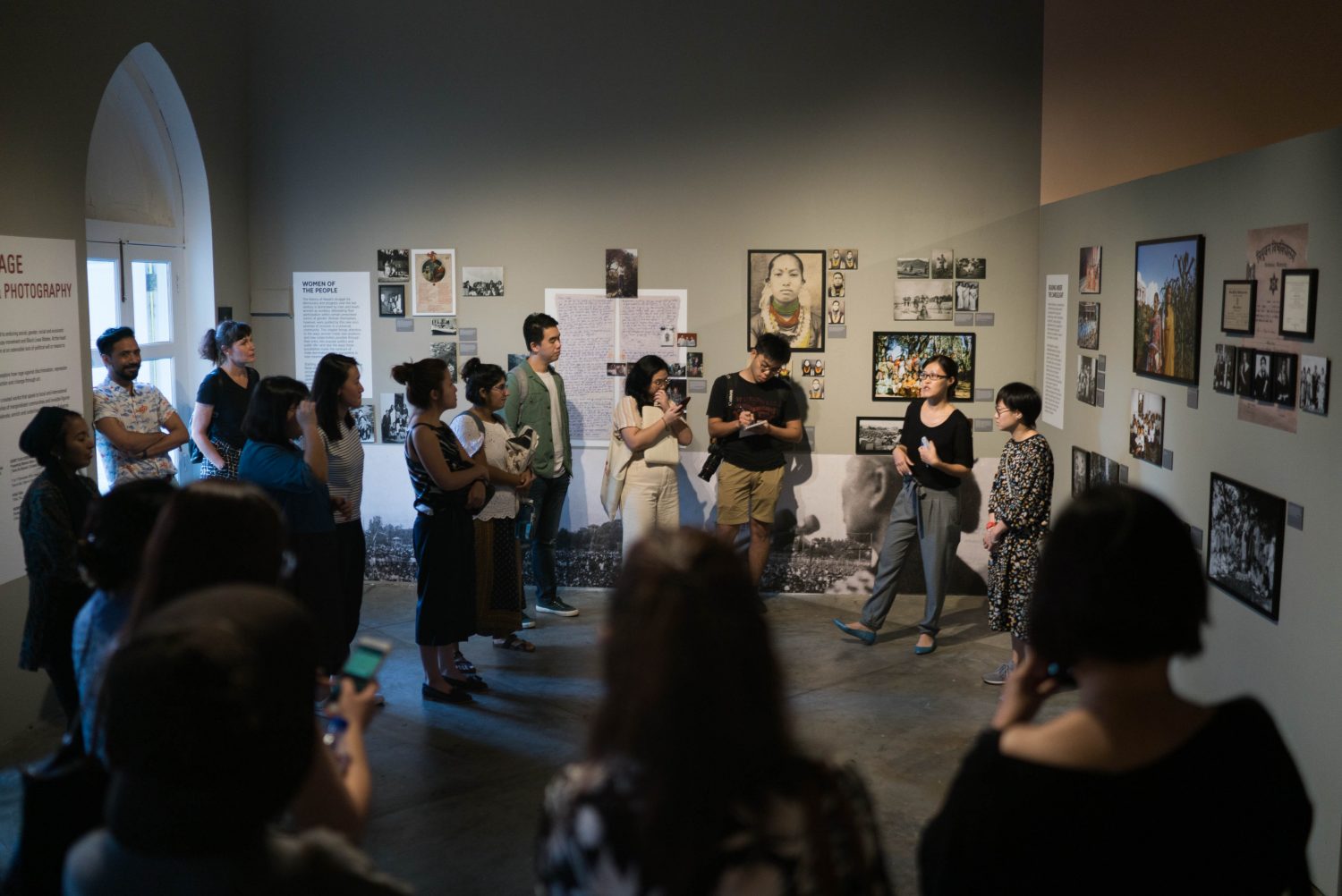The exhibiting artists on Remedy for Rage
Objectifs’ fifth Women in Photography exhibition opened on 10 Oct with the theme Remedy for Rage. Three of the featured photographers — Taslima Akhter, Ashfika Rahman and Mathilde ter Heijne — and Diwas Raja Kc, a curator from Nepal Picture Library, were in attendance. Read on for a recap from their artist talks, which have been paraphrased for brevity.
TASLIMA AKHTER
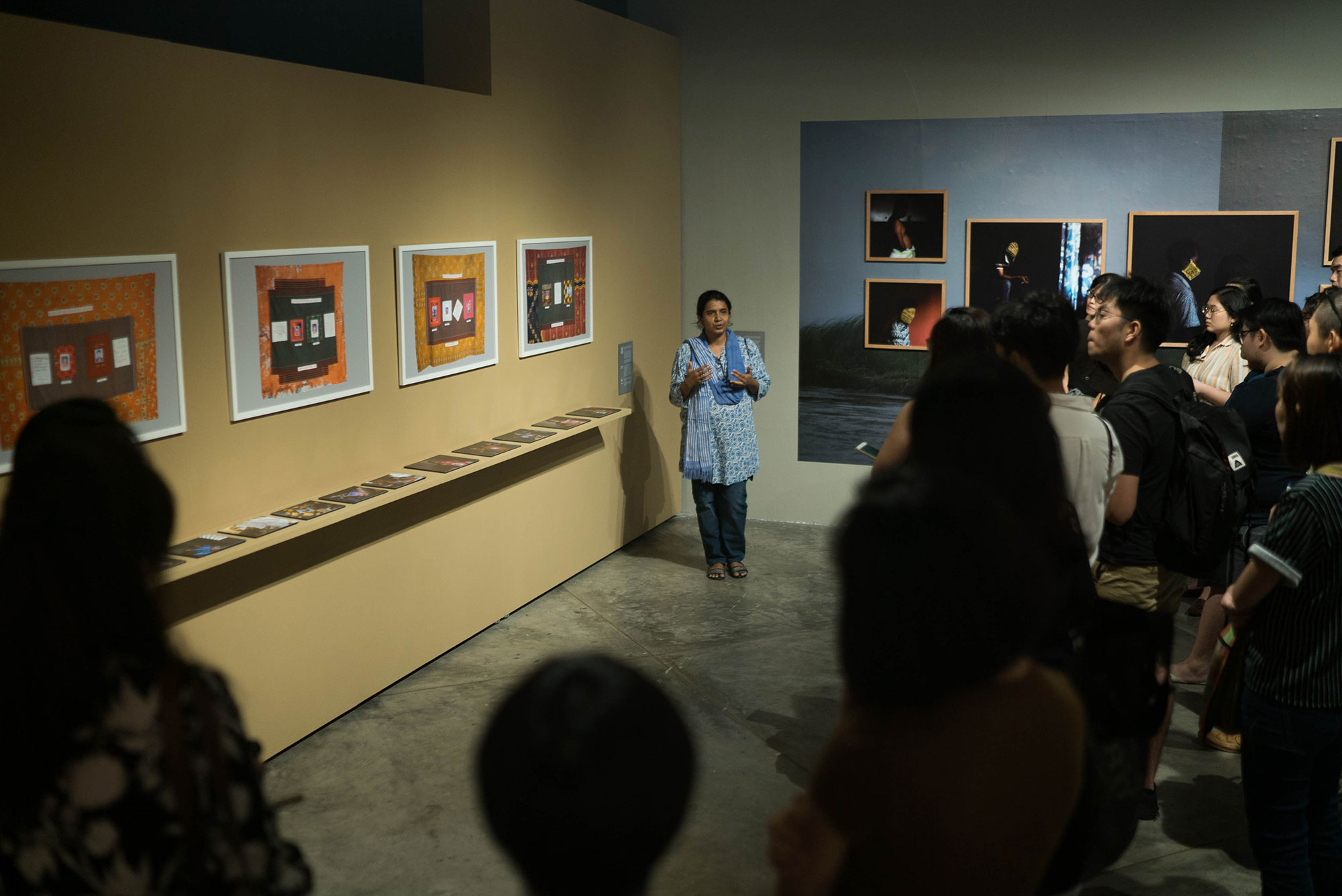
Taslima Akhter shares about her project “Stitching Together: Garment Workers in Solidarity” during a guided tour of the Women in Photography exhibition.
Taslima Akhter was born in a “very conservative family” as the youngest of seven children. She was aware from childhood that her father was the household’s decision maker and that he supported her brothers more than her. She said: “This discrimination made me uncomfortable. I realised that if I wanted an independent, emancipated life, we would need to change society.” At university, she became more interested in working with working class women and issues surrounding workers’ rights. She went on to explore her interest in photography at Pathshala South Asian Media Institute.
There are around four million garment workers in Bangladesh, and this sector generates about 80% of the country’s total export revenue. Given their importance to the economy, there is scrutiny when workers try to organise and speak up on class and labour issues.
“I discovered photography could be a powerful language for activism.”
“There was an ongoing movement to increase minimum wage, and I followed garment workers’ daily lives and struggles. I thought I could discuss their wage conditions by showing their living conditions. After a year of being in touch, they did not feel so conscious about my presence. I tried to document reality, and also understand other things about them. They also have dreams and joys like all humans. They are not in “pain mode” all the time or looking for rescuers.
The garment workers have inspired me. When I see organised workers giving strong speeches in front of hundreds of police I am inspired by their strength. The presence of women in this new labour force who are raising their voices for their rights (wages and working conditions) will lead us in women’s issues and the democratic transition issues of our country.”
In her series Dream & Reality, Taslima juxtaposed garment workers’ posed portraits with their family photos side by side, in an attempt to understand and share how she represented them as a documentary photographer versus how they wanted to be seen. She learnt that “everyone wants to show themselves in a dignified way”.
After the Tazreen Fire in Nov 2012, where more than 100 died, Taslima “had to change [her] focus from daily life”. On 24 Apr 2013, the Rana Plaza collapse unfortunately followed, with more than 1,100 deaths. She said: “When I started photographing garment workers in 2007-08, it was difficult as friends and journalists were working on hot issues, and this was not a hot issue then. But after Rana Plaza, many worked on it. What they did — photojournalists like Abir Abdullah and Suvra Kanti Das— was also important as they raised the issue locally and globally.
During her talk, Taslima displayed two of the original quilts from Stitching Together: Garment Workers in Solidarity which were made on the fifth anniversary of the Rana Plaza collapse. Fifteen women stitched the quilts, and their names and organisations were intentionally embroidered on the quilts to make their participation visible and to challenge perceptions of working class women’s involvement with art. The workers and their families also curated the exhibition in Bangladesh, which moved to three different galleries for different audiences.
While garment workers’ minimum wage rose last year, their struggle for fair pay and safe working conditions still continues. After the Rana Plaza collapse, international attention increased, but there is much more to be done. Taslima emphasised that we are globally implicated as “we wear the clothes they make, and the lion’s part of profits goes to the international brands they work for”. As the slogan embroidered on one of the quilts reads: “Remember the dead and fight for the living”.
ASHFIKA RAHMAN
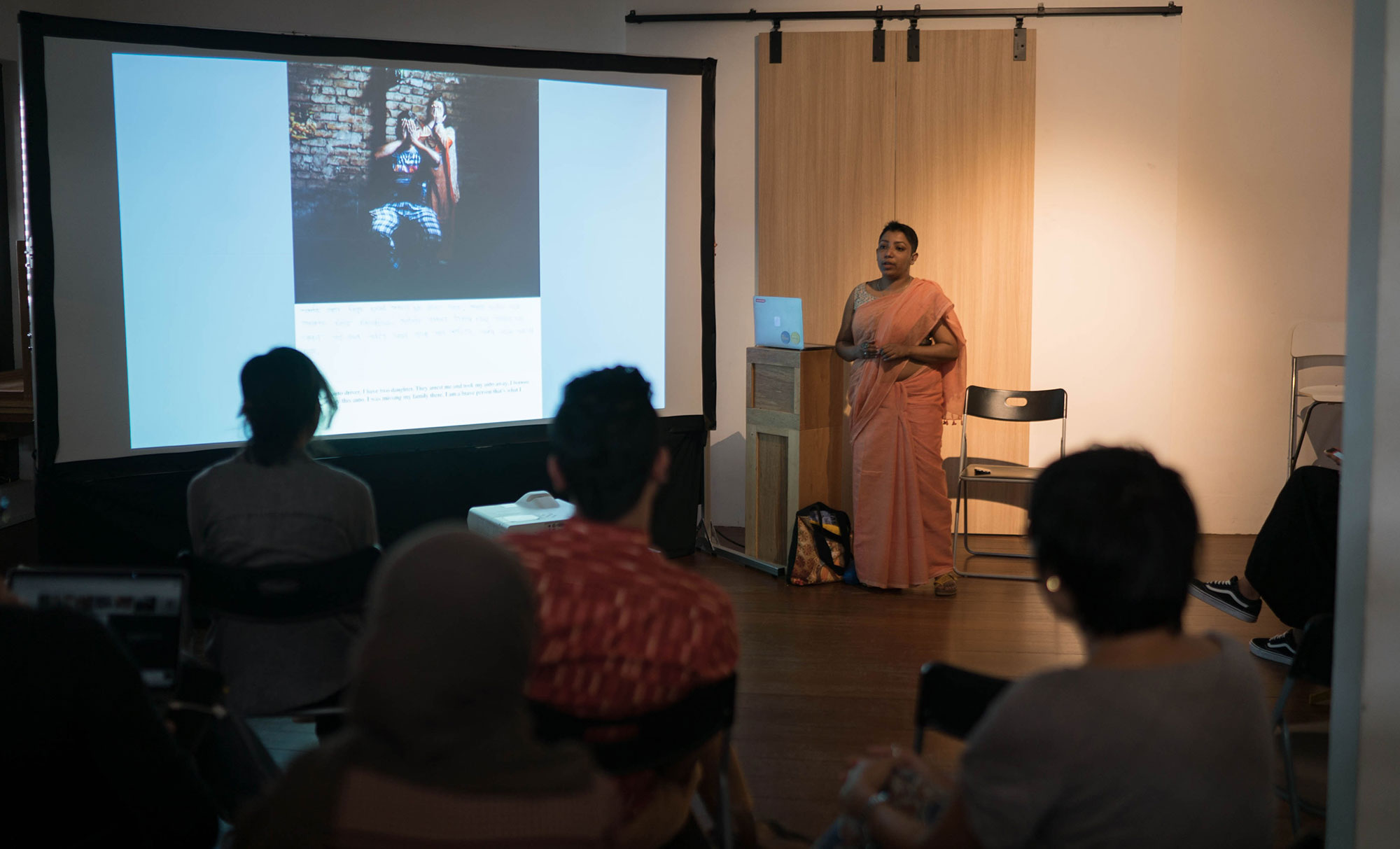
Ashfika Rahman gives her artist talk on her art practice and her series “Files of the Disappeared”.
Ashfika Rahman grew up conscious of social issues as her mother, a social worker, would sometimes host people she supported in their home. Ashfika would sometimes assist her cousin, a pictorial photographer, and took a short course at Pathshala South Asian Media Institute, where she learnt about telling stories or sharing one’s perspective through visuals, and realised this was “exactly what [she] wanted to do”.
Ashfika said: “Whenever we are working in any media, we should look inside ourselves.” As she worked on numerous assignments, it became apparent that she had an interest in “social issues, people, their problems, pain”.
In her third year, she started her first long term project, Rape is political, which is set in the Khagrachari hills, a mountainous area at the border of Bangladesh, Myanmar and India. Young indigenous girls and women living there have been raped. Ashfika made portraits of the survivors, whom law enforcement does not assist, while their own community believes their purity has been compromised. Ashfika said of her process:
“How can I express complex politics in one photograph? How can I make the individual images more than photographs? I wanted to make a volume of documents, so that the issue could not be ignored, and claimed as random incidents.”
“Photojournalists’ photographs do not tell everything, they are subject to media censorship too. As an artist, I have the tools and I have the privilege to cover the same subject in a different way which cannot be told in the mainstream media.”
Each element in the Rape is political portraits is a deliberate decision. “The survivors are strong and should be represented with dignity and power. The handmade works and words are a tribute to the indigenous people. Finally, my point was to confront viewers. We have to question why we do not expect that victims can be graceful and strong. They should not have to hide their faces, criminals should be the ones doing so. At the same time, I have to be responsible on what I reveal of people’s identities, even if they do not express any reservations. So, we chose motifs from their own clothes to partially obscure some revealing details.”
Files of the Disappeared, currently exhibited at Objectifs, bears similarities to Rape is political. Ashfika said: “My purpose was to make a file of people who have been disappeared by law enforcement agencies. According to domestic records more than 400 people disappeared in 2014 and more than 4,000 before the elections. Some came back, some didn’t, and some of those who did weren’t allowed to speak about it.
Some of the formerly disappeared who returned were going through depression, anxiety, suicidal tendencies. Some may desire to join militant or extremist groups as they had fear, anger and revenge on their minds. They couldn’t pick up their former lives when they returned. I roped some psychologist and counsellor friends into the project. I wanted to create a movement to let them connect with each other and heal together. I may not follow their journeys forever, but they may follow each other. I am still trying to find ways to tell such stories.”
MATHILDE TER HEIJNE
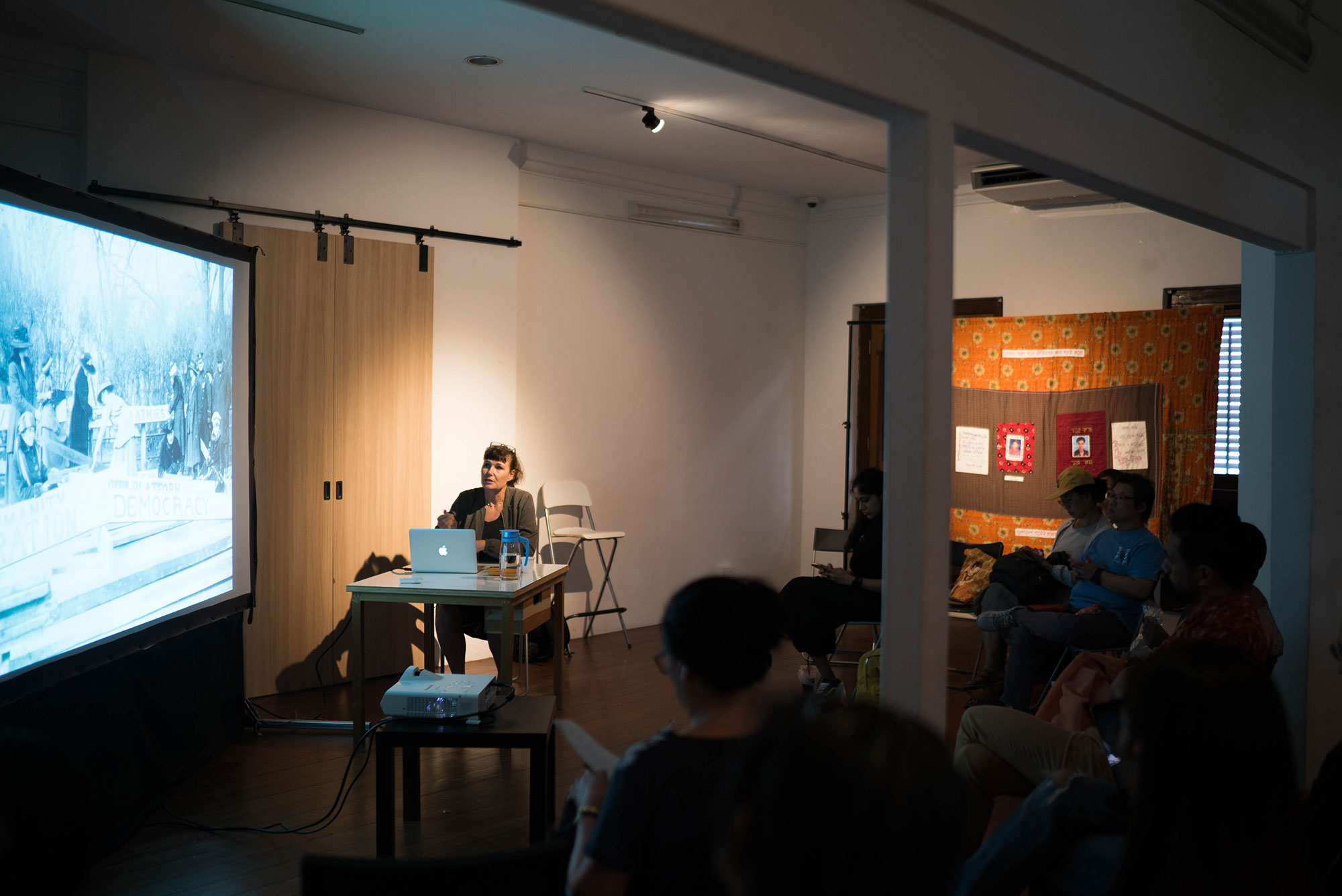
Mathilde ter Heijne gives her artist talk on her art practice and her project “Woman to go”.
Mathilde ter Heijne has been working as an artist for 30 years and has a broad praxis. In her presentation, she focused on her works that deal with archive material. Like the other works exhibited in Women in Photography 2019: Remedy for Rage, her series Woman to go is about “getting stories out, looking at things that tend to get forgotten, structures that seem impossible to change”.
Woman to go started in 2005 and uses materials from archives all over the world. Though the series is not focused on present times, it “might reflect violent structures we still live in nowadays”. “I was looking for women who were trying to change the world in the 19th century. It was an interesting period, when women were trying to take their lives and work into their own hands. We tend to think that women’s movements started in the US but there were other places where women became active in advocating for their own rights. I think the 19th century is where feminism comes up.”
The postcards in Woman to go, which people can take away, show unknown women on the front. We do not have their name or much information about them; there might be a credit line from an archive, the photo studio, or the photographer’s name. On the back, there is a writeup of another woman from history, whose name and details of her life are known. The biographies of these ‘known’ women come from different parts of the world, including China, Japan, India, the US and Australia, reflecting the courage and tenacity of women of different backgrounds. Mathilde said of her project:
“I was trying to find out if you can read history in another way or if you can make up your own history. What kinds of history can you come up with? By reading the writeup on the back, you get a sense of difficulties women came across in their lives and what they tried to do to change their situations.
It is also a way of liberating images from museum archives, which they don’t want to show because it exposes our own colonial background, which they are ashamed about. So it also works on the level of revealing information that people try to keep under the table.
DIWAS RAJA KC

Diwas Raja Kc gives his artist talk on the work of the Nepal Picture Library and the exhibition “The Public Life of Women — A Feminist Memory Project”
Since 2011, the Nepal Picture Library has been collecting, digitising and documenting photographs from all types of sources with the objective of “safeguarding a visual repository of ordinary life, social history and public culture in Nepal”. They believe such an alternative archive can boost historical awareness by depicting a vision of Nepali society that people can see themselves reflected in. They also feel that “images and narratives of the past need to be freed from the grips of economically and culturally dominant groups and depict the diversities, differences and dissensions of Nepali society”.
The Nepal Picture Library is “an attempt to reimagine what a useful archive means”, and so its principles of selection and inclusion differ from those of a more conventional or institutional archive. Diwas said: “The value of the archived materials cannot be defined in the same way. Our primary materials are ephemeral, mainly photo albums but increasingly also notebooks, letters, scraps and diaries whose values tend to be personal and determined by the donors who have preserved these items for mainly emotional and affective reasons. The definition of ‘archive’ is expanded to include domestic spaces. What happens when we think of home — small collections kept by women in their kitchens and bedrooms, for example — as a foundation for, evidence of history?”
The Feminist Memory Project, a portion of which is shown at Objectifs, is “a dedicated visual archive of women’s history in Nepal to examine how publicness itself has emerged as a key feminist strategy in Nepal”. Its main objective is to “work against the routine oblivion that the archive and public memory deal to women”. Diwas presented several sets of images and detailed their acquisition and significance, through which he illustrated the Nepal Picture Library’s approach to their research:
One such example is a collection includes a group of photographs of indigenous women who led a peasants’ movement against local landlords 40 years ago in one of Nepal’s southern districts. A research fellow tracked down each woman, who are all dispersed now, to put together the collection. They noted how this movement only resided in the memories of the women involved, and otherwise forgotten, aside from occasional appearances in the communist party’s chronicles, it was excluded from the annals of Nepal’s national history at it did not match “narratives of development, modernity nor political radicalisation” unlike the Maoist insurgency in Nepal (for example). Yet, it was a real example of how rural women had organised themselves and struggled for justice, and demonstrated feminism “based on bonds of sisterhood, not kinship”.
The “go-to methodology” for the Feminist Memory Project’s research team has been to “rely on photographs as memory triggers”. Diwas described this as “photo elicitation” or “performative viewing of photographs”; the team “reports how people speak about their own images and the meanings and values they assign to the photographs. Memories around photographs tend not to be merely anecdotal but are shot through with deep interpretations of structures of history, and reveal attitudes towards the post. Our goal is to discover how individual memories triggered by photographs may relate to collective forms of memory, and how they figure into an understanding of the social world and history”.
Women in Film & Photography: Remedy for Rage’s ongoing exhibition and short film installation continues at Objectifs till 17 Nov. (Open Tues to Sat, 12pm to 7pm and Sun, 12pm to 4pm)
Join us for the following events this week:
- Thurs 7 Nov, 7.30pm to 8.30pm: Artist talk for Remedy for Rage: Short Films
- Fri 8 Nov, 7.30pm to 9.30pm: Screening of The Reformist (rating TBC) followed by post-screening discussion with Nurul Fadiah Johari and Filzah Sumartono
- Sat 9 Nov, 2.30pm to 3.30pm: Women in War: Performance-Talk by Nurul Huda Rashid
Recaps of the post-screening discussions for selected films from Women in Film: Remedy for Rage are also available on our website.
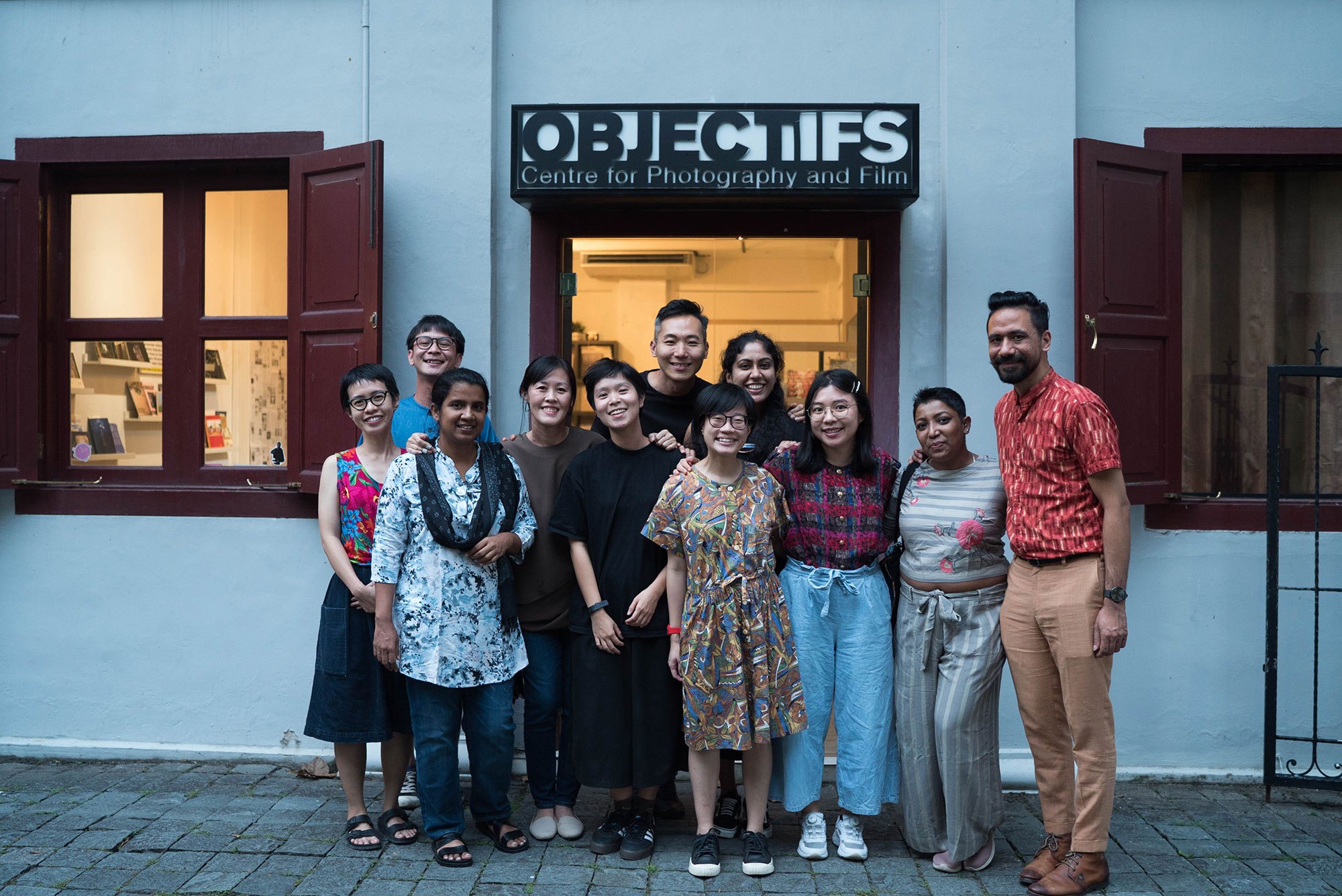
The visiting artists and curators with Objectifs staff

